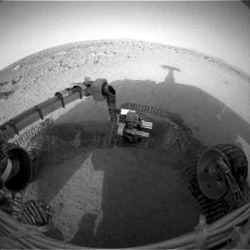

NASA’s Mars Exploration Rover Spirit. Image credit: NASA/JPL-Caltech. Click to enlarge
Spirit, the untiring robotic “wonder child” sent by NASA to explore the eerily earthlike fourth planet from the sun, has completed one martian year–that’s almost two Earth years–on Mars. Designed to last only 90 martian days (sols), the six-wheeled marvel the size of a golf cart has pursued a steady course of solar-driven geologic fieldwork, bringing back some 70,000 images and a new understanding of Mars as a potential habitat.
During Spirit’s martian year, the seasons have changed from summer to winter and back again. In its orbit around the Sun, Mars has returned to where it was when the rover first landed. Having survived seven times its expected lifetime and traveling over 3 miles (about 5,000 meters), Spirit is still going strong.
Hill Climbing with Spirit
“When we first took a look around after landing,” noted Cornell geologist and principal investigator Steve Squyres, “the ‘Columbia Hills’ seemed impossibly far away. Given its longer life, though, Spirit reached them and became the first explorer to climb a mountain on another planet. ‘Husband Hill’ is about as tall as the Statue of Liberty, but for a little rover, that was a heck of a climb.”
To achieve that feat, Spirit’s handlers painstakingly plotted a path up the slopes to keep the rover alive during the colder months of the martian year. A few months into the mission, winter was fast approaching and the Sun was ever lower above the northern horizon.
“We followed a circuitous path uphill, using the higher, uneven terrain to tilt the solar panels toward the Sun, keep the communications antenna facing Earth, and avoid rocks along the way,” said rover driver Chris Leger at NASA’s Jet Propulsion Laboratory.
While keeping warm in the winter, Spirit’s uphill battle also centered on what NASA sent both rovers to find: signs of past water on Mars. If water persisted for long periods of time in martian history, the red planet might have once had a life-supporting environment. At first, Spirit’s studies showed plenty of volcanic rocks, but few signs of minerals formed by water.
“Only by climbing did Spirit find what we were seeking,” said Ray Arvidson, deputy principal investigator from Washington University in St. Louis. “With Spirit’s engineering stamina, we finally found rocks in the ‘Columbia Hills’ that either formed in, or were altered by, water. Perhaps best of all, the hills hold the highest sulfur content ever found on Mars: sulfate salts, deposited by water.”
Besides finding these prized signs of past water on Mars, Spirit has discovered at least five distinct classes of rocks. Among these are molten rocks blasted upward and outward during meteorite impacts, materials formed during violent volcanic explosions, and lava flows. Beyond these large features, Spirit has taken a close look at grain-sized rock particles as well. “At a small scale, the geology of ‘Husband Hill’ looks like it’s been put in a blender,” said Squyres.
“All of this variety churned up in the rock record shows how volatile Mars was in the past,” Arvidson says. “Rocks in one layer say volcanoes were exploding, in another that lava was flowing, in another that water was seeping. And then imagine that some massive geologic force uplifted the whole of ‘Columbia Hills,’ exposing all of these layers to millions of years of wind erosion, gravity-driven landslides, and meteorite impacts.”
Seeing this rich geologic record on the north side of the Columbia Hills, Arvidson says, heightens the science team’s anticipation of what more they will learn about the history of the hills during Spirit’s trek down the other side.
Raising Spirit’s Energy
For Spirit’s continued journey, engineers are delighted with the unlikely role the martian wind has played in increasing the rover’s staying power. A peak threat of wind is the planet-encircling dust storms that can arise in martian spring through early summer, blocking out sunlight needed for power. “Luckily,” said project scientist Joy Crisp, “we haven’t yet seen a global dust storm since the rovers landed on Mars, but we have seen a lot of dust devils.”
Dust devils occur when the wind whirls over the surface, stirring dust up like a miniature tornado and traveling up to 13 feet per second (4 meters per second). It turns out the dust devils are primarily a lunchtime affair, mostly occurring between 11 a.m. and 3 p.m. at each rover site. For both rovers, these noontime winds have been very favorable.
While dozens of dust devils have passed before Spirit’s cameras, some have made contact, sweeping dust from the rover’s solar panels. The solar panels are then able to take in more sunlight and convert it into electricity, keeping Spirit “alive” for even longer.
Keeping Spirit Alive
While no one can predict how long Spirit will last, the rover’s stamina throughout the long martian year encourages hope. The science team is busy even now plotting new destinations to strive toward. If the “Columbia Hills” were once a distant dream, new far-off horizons beckon just as much. Getting there will stretch the rover’s capabilities as much as the imagination. Team member Jim Rice calls one such distant target, a rough and rugged terrain to the south, “the Promised Land.”
One thing is sure. No matter what the future holds, Spirit is already there.
Original Source: NASA News Release
Chemical rockets are loud, noisy and can only get us so far. If we want…
Any satellite sent to space must be able to deal with the battle with Earth's…
NASA's asteroid-studying spacecraft Lucy captured an image of its next flyby target, the asteroid Donaldjohanson.…
If you've ever looked at Mars through a telescope, you probably noticed its two polar…
Our Solar System is in motion and cruises at about 200 kilometres per second relative…
Late is better than never for the ‘Blaze Star’ T Coronae Borealis. It was on…